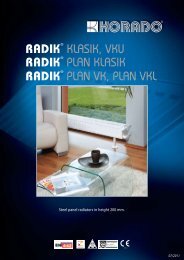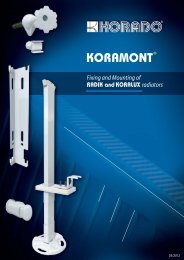RADIK are steel panel radiators - KORADO, as
RADIK are steel panel radiators - KORADO, as
RADIK are steel panel radiators - KORADO, as
Create successful ePaper yourself
Turn your PDF publications into a flip-book with our unique Google optimized e-Paper software.
SVÚOM PRAHA – INFORMATION<br />
(I.E. STATE RESEARCH INSTITUTE FOR PROTECTION OF MATERIALS)<br />
That is why the guaranty claims resulting from the title of corrosion<br />
or from a change of the surface appearance cannot be applied<br />
on those <strong>radiators</strong> which <strong>are</strong> placed within reach of water spray<br />
or within reach of aggressive solutions (C2 – C 5 spaces).<br />
In c<strong>as</strong>e it is necessary to place <strong>radiators</strong> within such a reach<br />
or in the middle of such an <strong>are</strong>a, special protective me<strong>as</strong>ures<br />
must be applied (e.g. using zinc-coated or corrosion more<br />
resistant sheets, appropriate enc<strong>as</strong>ing etc.) which prevent<br />
corrosion damage of the surface finish of the <strong>radiators</strong> in<br />
question.<br />
Radiators with surface finish complying with the DIN 55 900<br />
standard can thus be installed in kitchens, bathrooms and<br />
toilets, provided they <strong>are</strong> located in the suitable place of the<br />
room.<br />
3.2 Spaces which <strong>are</strong> unsufficiently<br />
air-ventilated<br />
These <strong>are</strong> rooms (spaces with C 2 interior environment air and higher)<br />
with windows which <strong>are</strong> never opened or rooms without windows<br />
where no sufficient air exchange can be achieved and maintained.<br />
In such spaces, humidity from air can often condensate on turned-off<br />
and therefore cold <strong>radiators</strong>. This condensated humidity can damage<br />
the protective coating due to corrosion or blistering.<br />
Regular air-ventilation of the heated rooms/premises is the necessary<br />
protection of the surface finish of <strong>radiators</strong> against humidity and<br />
condensated water. It is not recommended, <strong>as</strong> a kind of protection<br />
against condensated humidity, to turn off <strong>radiators</strong> which <strong>are</strong> placed<br />
in unsufficiently air-ventilated rooms.<br />
Using <strong>radiators</strong> complying with the surface finish according to DIN<br />
55 900 inside bathrooms, toilets and launderettes (without windows)<br />
is possible only if air-ventilation is maintained in accordance with<br />
DIN 18 017 standard, Part 1 and Part 3, wherein hour exchanges of<br />
air volumes <strong>are</strong> defined. Analogically, requirements re. temperaturehumidity<br />
microclimate <strong>are</strong> given in ČSN EN ISO 7730 standard.<br />
If no regular air-ventilation is possible, or if no permanent air exchange<br />
can be achieved, <strong>radiators</strong> must be in continuous operation<br />
so that cooling down of such surfaces is prevented where air humidity<br />
would condensate.<br />
Users of such unaired and humid rooms (e.g bathrooms, launderettes)<br />
must respect this fact. C losed rooms with installed <strong>radiators</strong> must be<br />
heated or air-ventilated regularly. Requirements defining air-ventilation<br />
of flats or houses <strong>are</strong> given in the following table:<br />
Room Air exchange rate<br />
Kitchen<br />
Bathroom, toilet<br />
Garage a) separate<br />
b) sh<strong>are</strong>d<br />
50 l/s – during operation<br />
12 l/s – with permanent air-ventilation<br />
or with opened windows<br />
25 l/s – when being used<br />
10 l/s – with permanent<br />
air-ventilation<br />
or with opened windows<br />
50 l/s – separate<br />
7,5 l/s car – sh<strong>are</strong>d<br />
3.3 Spaces with permanent incre<strong>as</strong>ed humidity<br />
or aggressivity of environment air<br />
This relates to critical rooms and premises (C2 – C 5), i.e. swimming<br />
pools, saun<strong>as</strong>, public toilets, car-w<strong>as</strong>hing facilities, laundry<br />
plants, battery recharging workshops, various premises in chemical<br />
and food processing industries, and rooms and spaces where wet<br />
cleaning is carried out by means of low or high pressure equipment<br />
etc. The <strong>radiators</strong> complying with DIN 55 900 <strong>are</strong> not suitable for<br />
application in such premises.<br />
If the said <strong>radiators</strong> <strong>are</strong> still to be installed into such difficult conditions,<br />
it is necessary to consult the manufacturer for the best possible<br />
placement of the <strong>radiators</strong> and to set limitations for usage of these<br />
<strong>radiators</strong> with standard surface finish. Inside the above mentioned<br />
critical premises there <strong>are</strong> usually also places with the corrossion<br />
impact of grade C 1, such <strong>as</strong> offices, changing rooms, workshops,<br />
dining halls etc. wherein the <strong>radiators</strong> complying with DIN 55 900<br />
can be applied without limitations.<br />
4. STORING OF RADIATORS AND MOUNTING OF<br />
RADIATORS<br />
The DIN 55 900 standard requires that <strong>radiators</strong> provided with the<br />
final surface coating must be appropriately protected for and during<br />
transportation and for storage and mounting and that it must be<br />
possible to clean the <strong>radiators</strong> surface with common detergents.<br />
The following advice is to be respected.<br />
4.1 Transportation<br />
During transportation but also during storage and final mounting<br />
of <strong>radiators</strong>, it is necessary to prevent any damage of the radiator<br />
coating and/or of all covering elements. No damage caused by rain<br />
or by any aggressive impurities may occur.<br />
4.2 Storage<br />
Radiators provided with final surface finish must be stored at the<br />
user’s in dry and well air-ventilated spaces so that no corrosion<br />
damage of the <strong>radiators</strong> surface finish occurs.<br />
4.3 Protection of the surface finish during<br />
mounting<br />
Mounting of the <strong>radiators</strong> is to be carried out in such a manner that<br />
the protective wrapping is removed only after all building construction<br />
jobs (e.g. floor tiling, concrete works, wall painting/ decorating<br />
and cleaning) h<strong>as</strong> been finished in order to prevent any damage<br />
of <strong>radiators</strong>, especially any damage of their surface finish. The<br />
<strong>radiators</strong> can be mounted and put into operation without removing<br />
the protective wrapping.<br />
4.4 Cleaning<br />
Radiators with final surface finish can be cleaned with such suitable<br />
water-borne detergents which <strong>are</strong> commonly used in households<br />
without any adverse impact on the painted surface. Such detergents<br />
must neither be abr<strong>as</strong>ive (they would abrade the surface) nor strongly<br />
alkaline or acidic (i.e. chemically aggressive).<br />
The company reserves the right to make technical changes.<br />
SVÚOM PRAHA – INFORMATION<br />
95





